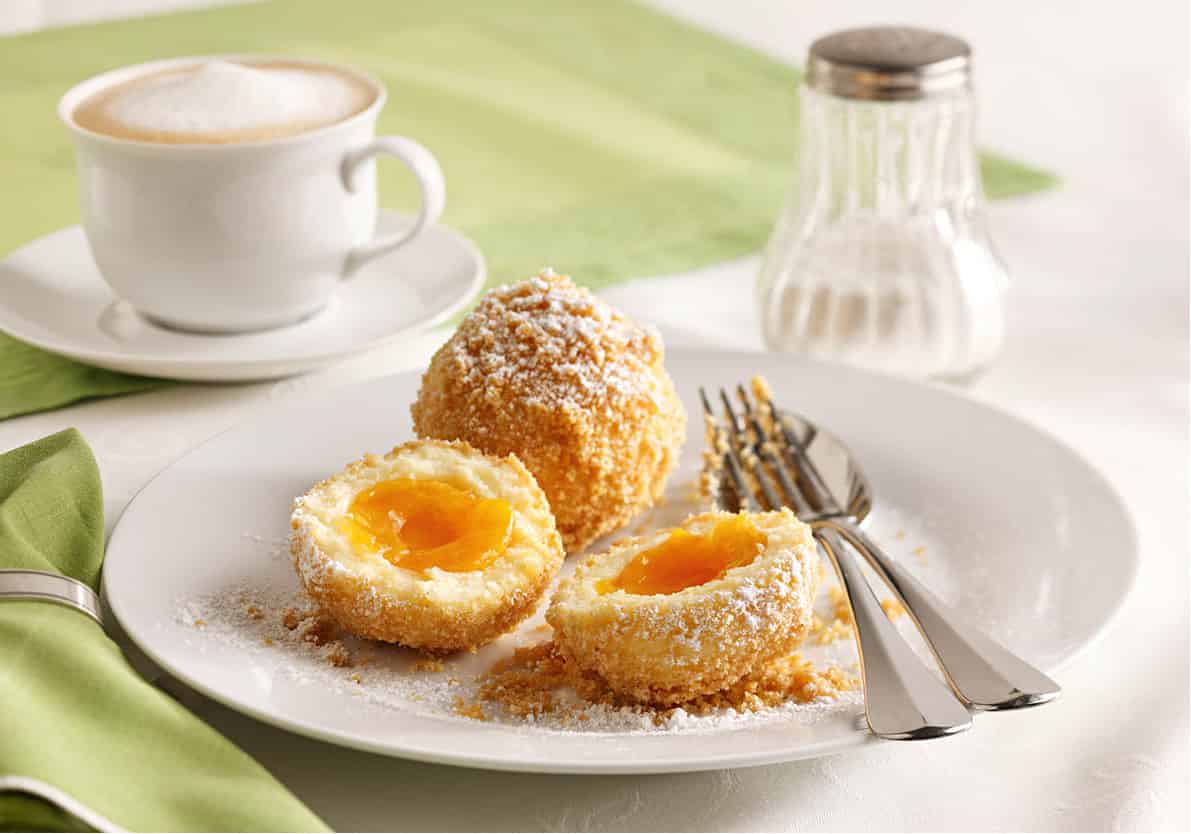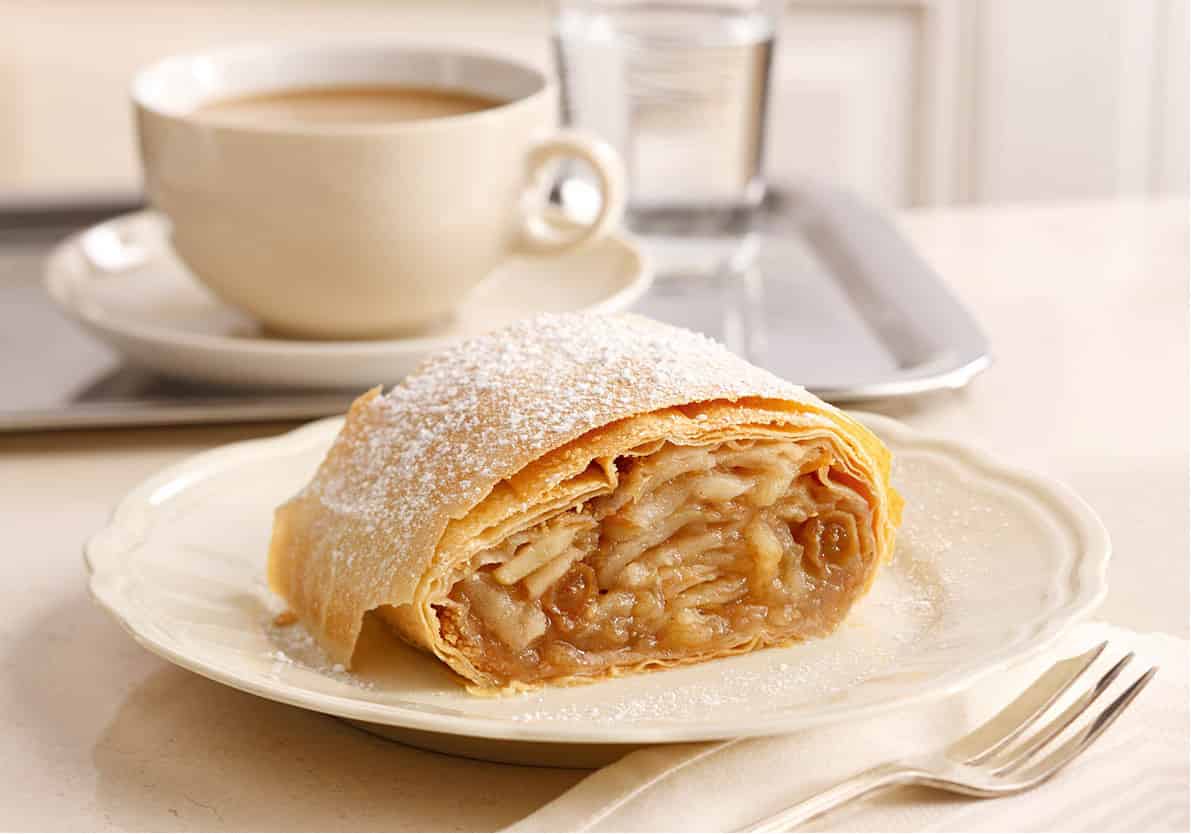Salzburg has a strong tradition of dining out. The oldest eatery in the city bears witness to this: St Peter Stidtskulinarium was established as a tavern by the monks of St Peter’s in 803. You will often see whole families gathered around a restaurant table, or large groups of friends out celebrating a special occasion. Meals are not hurried and it is not unusual for people to spend a whole evening in a restaurant relishing a hefty three-course meal, with beer and wine flowing freely.

Stopping for a lunch of bread, cheese and meat
Austrian National Tourist Office
Summer is the time for eating outdoors. Many restaurants have gardens or, at the very least, tables on the pavement. Remember, however, that Salzburg is near the Alps and that even in summer you might want a jumper or jacket.
Local delicacies
What to eat
Austrian cuisine is still more seasonal than in many other countries, especially regarding fruit, vegetables and herbs. Markets with fresh produce from the area play an essential part in the culture of home and especially restaurant cooking. Although the choice of fresh and packed products has widened immensely, you might not find the extreme array of convenience foods found in some supermarkets in the Anglo-Saxon world.
Salzburg has collected influences from all over Europe, especially the Austro-Hungarian Empire and, more recently, has been inspired by international cuisine. The Turks brought coffee and the coffee culture to Austria during the siege of Vienna in the 17th century; Gulasch and salamis come from the Hungarian part of the Austro-Hungarian Empire and some people even claim that the Schnitzel originated in Italy.
Meat
Traditionally, Austrian food has evolved around meat. Pork is the most popular item on the menu, closely followed by beef. Two of the classic meat dishes are Schweinsbraten (roast pork) and Zwiebelrostbraten (roast beef with gravy and onions). If you are a hungry carnivore and find it difficult to make up your mind, a Grillteller (mixed grill) is a good choice for sharing.
Vegetables
Vegetables are beginning to play a more important role as main dishes. As side dishes you will enjoy a lot of seasonal varieties. If you are here in the summer or autumn, the wild mushrooms (Pilze) are wonderful. In winter, pumpkins and root vegetables come into their own; Schwarzwurzel (black salsify) and Kohlrabi (a member of the cabbage family) are among the most popular. Finding good vegetarian food in Austria used to be a hopeless cause, but now nearly all restaurants offer a vegetarian alternative. There are also several vegetarian eateries (for more information, click here, click here or click here). Organically grown produce is very popular here and you will find several restaurants and shops offering Bio produce.
Seasonal specialities
No matter what time of year you visit Salzburg, there is always some seasonal speciality on offer. In spring and early summer it’s asparagus; in late summer it’s Eierschwammerl (chanterelle mushrooms); in autumn it’s game; in November it’s goose; and at Christmas it is mulled wine and roast chestnuts. Austrians do not have a typical Christmas meal. Here it is traditional to eat fish on Christmas Eve, but steak or any other special treat are also options. Gingerbread and Christmas biscuits (Kekse) are the sweet specialities. On New Year’s Eve, a fondue with either cheese or meat is a typical dish as it makes for a genial atmosphere around the table.
Bread and cheese
If you are looking for a snack or a light lunch, the wonderful dark Austrian breads are perfect to enjoy with a plate of Austrian cheeses or Speck (a dry-smoked bacon). There are many different types of cheese, ranging from strong-flavoured hard mountain cheeses to more gently flavoured soft cheese dips and spreads.

Marillenknödel are apricot dumplings
Austrian National Tourist Office
Desserts
During the hardships of World War II, people had to make do with the ingredients available to them. This has led to a love of desserts made from eggs, flour and milk. Many of the sweet dumplings, cakes and pancake-type dishes stem from these times. Although made from the simplest of ingredients, they can all be extremely delicious.

Apfelstrudel
Austrian National Tourist Office
Coffee and cakes
The city is awash with cafés of all styles, and anybody spending a few days here will see that they play an important role in the social life of Salzburg’s citizens. Nobody is in a hurry. The coffee-house culture means that you can sit over one cup of coffee, reading the café’s newspapers and magazines, for as long as you want. This is just as well, as the first glance at the menu will reveal that coffee is not simply coffee. There are many types to choose from. All coffee served is made with espresso machines (the only time you might be served filter coffee is with breakfast in your hotel). The following list should help when choosing.
Verlängerter: A ‘normal’ cup of coffee made with one portion of espresso to two portions of water.
Espresso: One portion of espresso mixed with one of water.
Cappuccino: One part espresso to one of warm milk and one of whisked milk.
Latte macchiato: A double espresso in a large cup or glass topped with steamed milk and froth.
Melange: One portion of coffee, two measures of water and hot milk.
Einspänner: One portion of black coffee served in a tall glass with whipped cream (Schlagobers) and icing sugar on top.
Fiaker: A single espresso served in a glass with a dash of rum.
Austrian fast food
It is hard to miss the usual fast-food outlets in Austria, but the international brand names are popular mainly with youngsters and tourists. True Austrian fast food comes in the form of the Würstlstand (sausage stand). These are scattered all over the city and you can usually find at least one open at any time of night or day. Sausages are available in all shapes and sizes, including Weisswurst from Munich, Frankfurters (hot dogs), Bosna (served with mustard, curry powder, ketchup and onions in a roll) and Käsekrainer (contains pieces of cheese).
You will also notice that you will be served a small glass of tap water with your coffee. This is a tradition that was brought in by the Turks. Their coffee was (and still is) famously ‘sludgy’, so it was normal to serve a glass of water with which to wash down the grounds. Nowadays this is no longer necessary, but the tradition has remained.
Of course, coffee is not the sole focus of these places – an amazing array of cakes and buns is on offer. Choosing a cake can be quite daunting when faced with so many different, delicious-looking cream cakes, fruit flans, biscuits and other sweet delights. The most famous are Sachertorte (a chocolate cake) and Apfelstrudel (apples and raisins wrapped in thin layers of pastry). But there are many others to tempt you. The Cremeschnitte is a cream slice; Topfen is cream curd used in many cakes that are often topped with seasonal fruits or berries; Linzertorte is a tart with jam and nuts. Mandeln (almonds) are also used in many biscuits and cakes; a particularly good one is Bienenstich (literally ‘bee sting’), a cake base filled with whipped cream and almonds with honey on top. A wonderfully gooey biscuit is the Florentiner (nuts and candied fruit covered in chocolate).

Steins of beer at the Augustiner Brewery
Britta Jaschinski/Apa Publications
What to drink
Salzburg is split between the beer and the wine lovers, and both are well catered for.
Beer
With three locally brewed beers on offer – Stiegl, Kaiser and Augustiner – all with long histories, you will almost certainly find a beer to your taste. You should try the Weissbier at least once. This is a cloudy beer as the yeast has not been entirely brewed out (though you can also get a clear variety). It comes in a light and dark form, with the dark version being somewhat sweet. Zwickelbier is another slightly cloudy beer, an unfiltered lager. Bockbier is available at certain times of year, usually Christmas and Easter, and is a stronger special brew which should be handled with care – perhaps start with just a Pfiff (0.2 litres) to test the effect. The beer-garden culture is alive in the summer, and sitting in one of the leafy gardens, enjoying a beer or two, is a wonderful way to spend an evening.
Salzburg’s taverns or Gasthäuser are an excellent combination of beer-hall and restaurant. You will often find some of the best Austrian food served in these establishments at very reasonable prices. For the most part they are traditional old taverns that have retained their wooden interiors and are cool in summer and cosy in winter.
Wine
If you have never tried Austrian wines, then the wine bars and restaurants in Salzburg are a good place to start. Although this is not a wine-growing region, wines from Styria, Burgenland and Lower Austria are all worth trying. After the Austrian wine scandal in the 1980s, sales of Austrian wine plummeted. Many winegrowers had to lift their game, and now produce extremely high-quality wines in order to prove that most of the Austrian vineyards should be taken seriously. Both the red and white wines are very palatable and the most common are: Grüner Veltliner, a light, dry, crisp white wine; Welschriesling, a fresh, fruity white wine; Zweigelt, a full-bodied dry red; and Blauer Burgunder (Pinot Noir), a fruity, soft red. If you do not know what to choose, your waiter will be happy to recommend a good bottle.
When in Austria in the late summer and early autumn, you should try Sturm. This is grape juice which is still fermenting and has about 4 percent alcohol and is very refreshing. The white variety tends to be drier than the red one.
Another Austrian speciality is Schnaps. This is a strong, clear spirit produced using a variety of different fruits. The most commonly available types are Obstler, made from apples and pears, Marillenschnaps, made from apricots, and Vogelbeer, made from rowan berries. Try one after dinner as a digestif. They are also commonly used as cure-alls in Austrian households.